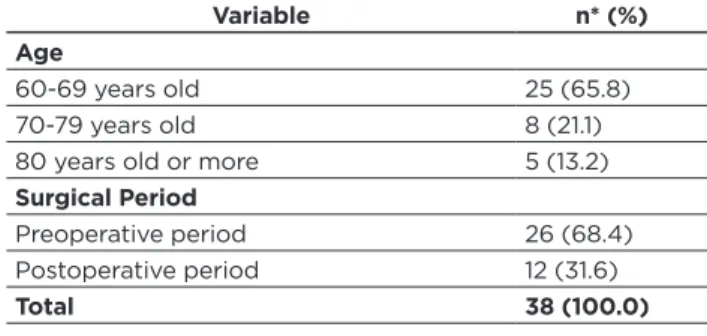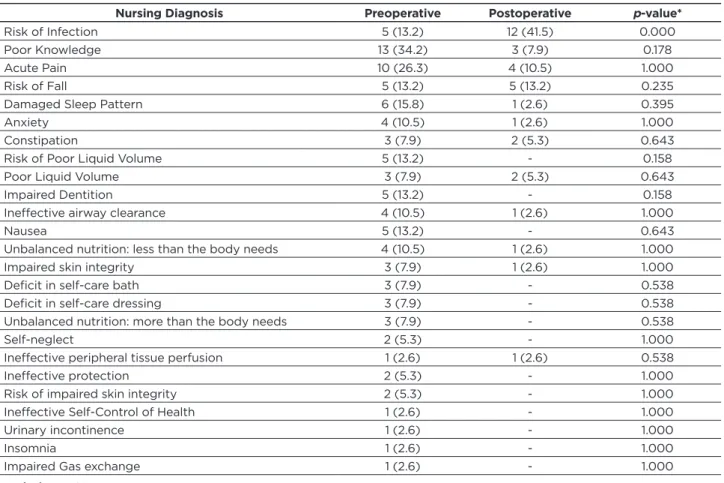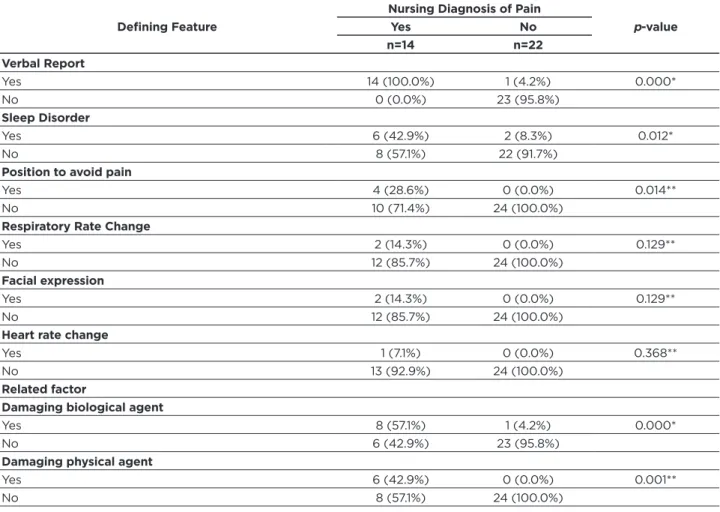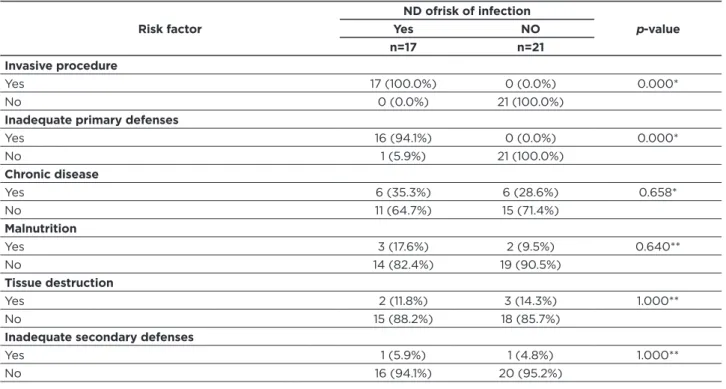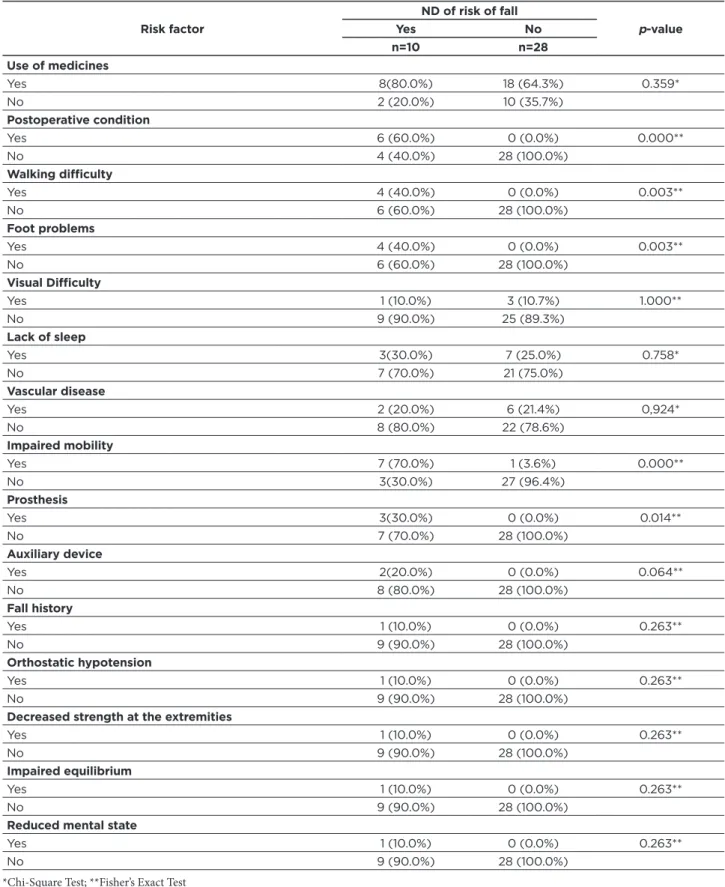CUIDADO É FUNDAMENTAL
UNIVERSIDADE FEDERAL DO ESTADO DO RIO DE JANEIRO . ESCOLA DE ENFERMAGEM ALFREDO PINTO
RESEARCH DOI: 10.9789/2175-5361.2019.v11i1.11-19
DOI: 10.9789/2175-5361.2019.v11i1.11-19 | Martins NFF; Silva BT; Abreu DPG; et al. | Nursing diagnoses in elderly people admitted in surgical unit
CUIDADO É FUNDAMENTAL
UNIVERSIDADE FEDERALDO ESTADODO RIODE JANEIRO. ESCOLADE ENFERMAGEM ALFREDO PINTOR E V I S T A O N L I N E D E P E S Q U I S A
Nursing diagnoses in elderly people admitted in surgical unit
Diagnósticos de enfermagem em idosos internados em unidade cirúrgica
1Diagnósticos de enfermería en ancianos ingresados en unidad quirúrgica
Nidia Farias Fernandes Martins;2 Bárbara Tarouco da Silva;3 Daiane Porto Gautério Abreu;4 Bibiane Moura daRosa;5 Juliana Piveta de Lima;6 Eliel de Oliveira Bandeira7
How to quote this article:
Martins NFF, Silva BT, Abreu DPG, Rosa BM, Lima JP, Bandeira EO. Diagnósticos de enfermagem em idosos internados em unidade curúrgica. Rev Fun Care Online. 2019 jan/mar; 11(1):11-19. DOI: http://dx.doi. org/10.9789/2175-5361.2019.v11i1.11-19
ABSTRACT
Objective: The study’s goal has been to identify nursing diagnoses for elderly patients in surgical units,
determine the prevalence of these diagnoses, and verify the association between the most prevalent diagnoses and the defining characteristics/risk factors. Methods: It is a descriptive-exploratory and cross-sectional study with a quantitative approach, which was carried out with 38 elderly patients admitted to a university hospital in the Southern region of Brazil. Data collection was performed by the application of the nursing history. The North American Nursing Diagnosis Classification and the SPSS software version 21.0 were used for analysis. Results: The elderly patients hospitalized in the surgical clinic showed an average of 3.4 (±1.9) nursing diagnoses and the most important were: Risk of Infection (44.7%); Poor Knowledge (42.1%); Pain (36.8%) and, Risk of Fall (26.3%). Conclusion: Nursing diagnoses make it possible to help the planning and implementation of nursing actions, taking into account the specificities of elderly patients.
Descriptors : RESUMO
Objetivo: identificar os diagnósticos de enfermagem em idosos internados em unidade cirúrgica, determinar a prevalência desses diagnósticos, verificar associação entre os diagnósticos mais prevalentes e as características definidoras/fatores de risco. Métodos: Estudo exploratório-descritivo, transversal, quantitativo, realizado com 38 idosos internados em um hospital universitário do sul do Brasil. A coleta de dados ocorreu por meio da aplicação do histórico de enfermagem. Para análise, utilizou-se a Taxonomia II North American Nursing Diagnosis Classification e o software SPSS versão 21.0. Resultados: Os idosos internados na clínica cirúrgica apresentaram uma média de 3,4 (±1,9) diagnósticos de enfermagem, e os mais prevalentes foram: Risco de Infecção (44,7%); Conhecimento Deficiente 1 Artigo extraído da monografia “Diagnósticos de enfermagem em idosos internados em unidade cirúrgica”, 2014. Universidade
Federal do Rio Grande (FURG).
2 Nursing Graduate, Specialist’s Degree in Family Health, Master’s student enrolled in the Nursing Postgraduate Program at FURG. 3 Nursing Graduate, PhD in Nursing by the FURG, Professor of both the Nursing School and the Nursing Postgraduate Program at
FURG.
4 Nursing Graduate, PhD in Nursing by the FURG, Professor of the Nursing Postgraduate Program at FURG. 5 Nursing Graduate, Master’s student enrolled in the Nursing Postgraduate Program at FURG.
6 Nursing Graduate, Master’s student enrolled in the Nursing Postgraduate Program at FURG. 7 Nursing Graduate, Master’s student enrolled in the Nursing Postgraduate Program at FURG.
(42,1%); Dor (36,8%); e Risco de Quedas (26,3%). Conclusão: Os diagnósticos de enfermagem possibilitam subsidiar o planejamento e a implementação das ações de enfermagem, levando em consideração as especificidades da pessoa idosa.
Descritores: Idoso, Diagnóstico de enfermagem, Enfermagem perioperatória, Enfermagem.
RESUMEN
Objetivo: identificar los diagnósticos de enfermería em ancianos ingresados en una unidad quirúrgica, determinar La prevalencia de estos diagnósticos de enfermería y verificar la asociación entre los diagnósticos más prevalentes y las que características definitorias/factores de riesgo. Métodos: Estudio exploratorio-descriptivo, transversal, cuantitativo, efectuado con 38 ancianos ingresados em un hospital universitário del Sur de Brasil. La colecta de los datos ocurrió mediante la aplicación del histórico de enfermería. Para análisis, se utilizo la Taxonomía II North American Nursing Diagnosis Classification y el programa informático SPSS, versión 21.0. Resultados: Los ancianos ingresados em la clínica quirúrgica presentaron um promedio de 3,4 (±1,9) diagnósticos de enfermería, y los más prevalentes fueron: Riesgo de infección (44,7%); Conocimiento Defectuoso (42,1%); Dolor (36,8%) y Riesgo de Caídas (26,3%). Conclusión: Los diagnósticos de enfermería permiten apuntalar la planificación y la implementación de acciones de enfermería, tomando em consideración las peculiaridades de la persona de avanzada edad. Descriptores: Ancianos, Diagnóstico de Enfermería, Enfermería Perioperatoria, Enfermería.
INTRODUCTION
Aging can be understood as a natural process of progressive decrease of the functional reserve of individuals. Under normal conditions, it does not cause problems, however, under overload conditions, such as illness, accidents and emotional stress, can cause a pathological condition that requires assistance.1
The elderly population, which has been growing significantly in Brazil, is increasingly facing Chronic Non-Transmissible Diseases (CNTDs) that have been the main cause of the hospitalization and death of these people, following a worldwide trend. Cardiovascular diseases and neoplasm, for example, are in the first place in the mortality index of the elderly. These complications can affect the functionality, which causes a dependence on the accomplishment of the Daily Life Activities (DLAs), causing loss of autonomy and independence and, consequently, affecting their quality of life. Therefore, they require constant monitoring.1-2
Considering the high rates of CNTDs, morbidity rates and the existence of pluripathogenic infections, surgical interventions have become increasingly frequent in the
establishment and development of nursing actions that meet the needs arising from surgical treatment.4
One of the ways which nurses are inserted in this context is through the implementation of the Nursing Process (NP): a private activity that assemblethe method and strategy of the scientific work for the identification of health/illness situations, supportingnursing actions that can contribute to the promotion, recovery and rehabilitation of the health of an individual, family and community, being its implementation in health services a means of improving the quality of the care provided.5-6
From this perspective, the needs of perioperative patients, specially the elderly ones, can be identified by the NP,constituting an appropriate work process practice to be developed by the nurse, which will allow to achieve integral attention through the systematization of the Assistance, stimulating the functionality and contributing to a greater independence and autonomy of the elderly.7
This study is based on the following questions: “Which Nursing Diagnoses (NDs) are the most prevalent in elderly patients hospitalized in surgical units?”;“Which defining features and/or risk factors of the most prevalent diagnoses are most frequently identified in this population?”; and“Is there an association between the most prevalent diagnoses and the defining characteristics/risk factors?”
In this context, this study aims to identify the NDs present in elderly patients in surgical units; determine the prevalence of these NDs; and verify the association between the most prevalent diagnoses and their defining characteristics/risk factors.
METHODS
It is a descriptive-exploratory and cross-sectional study with a quantitative approach, which was carried out in a surgical unit of a university hospital in the Southern region of Brazil. The inclusion criteria were: elderly patients having age equal to or greater than 60 years hospitalized in the Surgical Clinic Unit (SCU) without exceeding 48 hours from the date of collection, regardless of the reason of the hospitalization. This criterion was used because there is no application of the NP in the SCU.Therefore, some patients may be hospitalized for a long period without any record of the nursing history. The limitation of 48 hours from the date of the hospitalization is an attempt to reduce biases and make the application of the nursing history an activity that is closer tothe recommended by the nursing legislation. Elderly patients who failed to communicate with the researchers were excluded from the
An authorization to carry out the study was requested from the headship of the university hospital. The research project was approved by the Research Ethics Committee, under the Legal OpinionNo. 133/2013. The application of the data collection instruments was carried outfollowing the guidelines of the Resolution No. 466/2012 from the National Health Council, which states the guidelines about research with human beings.
For data analysis, a descriptive and inferential statistics were used with the aid of the SPSS software (version 21.0) for Windows. For the descriptive analysis, we considered the absolute and percentage frequencies for categorical variables and measures of central tendency and dispersion for the numerical variables. Pearson’s Chi-Square Test was used to analyze the association between the categorical variables. Fisher’s Exact Test was applied when the expected frequencies of the categorical variables were less than five. A level of 5% was adopted for the statistical significance.
The association present in the defining characteristics or risk factors was verified only for the NDspresent in more than 20% of the sample. The Prevalence Ratio (PR) values and their 95% Confidence Interval (CI) were calculated only for the defining characteristics that showed association with the NDs.
RESULTS AND DISCUSSION
The majority of the elderly patients in the surgical clinic unit were men (55.3%), with incomplete Elementary Education (50.0%), aged between 60 and 69 years (65.8%), and in the preoperative period (68.4%), according to Table 1. Table 1 - Distribution of the elderly patients in a surgical clinic unit according to gender, education degree, age group and surgical period. Variable n* (%) Gender Female 17 (44.7) Male 21 (55.3) Education degree Illiterate 7 (18.4)
Incomplete Elementary Education 19 (50.0)
Elementary Education 5 (13.2)
Incomplete High School Education 2 (5.3)
High School Education 3 (7.9)
College Education 2 (5.3)
Variable n* (%)
Age
60-69 years old 25 (65.8)
70-79 years old 8 (21.1)
80 years old or more 5 (13.2)
Surgical Period
Preoperative period 26 (68.4)
Postoperative period 12 (31.6)
Total 38 (100.0)
*n=38
In this study, males were the majority, representing 55.3% of the sample, being a fact also observed in a research performed in elderly patients in Fortaleza city, Ceará State, Brazil.9 More than half (68.4%) of the patients do not have Elementary Education degree, and only 5.3% of them have College Education degree. This fact shows a low level of education when compared with the elderly population in Brazil.10 This is a factor that may, for example, make it difficult to understand the guidelines received regarding perioperative care, thus compromising the recovery. In this sense, it is necessary to adapt the guidelines and have a continuous evaluation, especially for elderly patients, regarding the understanding of these guidelines, in the planning of the perioperative nursing care.11
The elderly patientsin the surgical clinic showed an average of 3.4 (±1.9) NDs, and the most predominant were: Risk of Infection (44.7%); Poor Knowledge, (42.1%); Pain (36.8%); and Risk of Fall (26.3%). Only the ND of risk of infection showed a significant association with the surgical period (p=0.000), according to Table 2.
The average of 3.4 ND per elderly person is below the average found in recent studies in Brazil, which show between 5 and 12 ND per elderly person.12-4 These differences may be related to differences in the identification of NDs and in the implementation of the NP, from institution to institution. The nursing process is not implemented in the study location. Nonetheless, some steps are performed by nursing students during practical activities and extension projects. This situation can be considered a fragility of the study, making the identification of the patients’ needs and the care planning difficult, from patient’s admission until his discharge.
Table 2 - NDs identified in elderly patients in a surgical clinic unit, according to the surgical period.
Nursing Diagnosis Preoperative Postoperative p-value*
Risk of Infection 5 (13.2) 12 (41.5) 0.000
Poor Knowledge 13 (34.2) 3 (7.9) 0.178
Acute Pain 10 (26.3) 4 (10.5) 1.000
Risk of Fall 5 (13.2) 5 (13.2) 0.235
Damaged Sleep Pattern 6 (15.8) 1 (2.6) 0.395
Anxiety 4 (10.5) 1 (2.6) 1.000
Constipation 3 (7.9) 2 (5.3) 0.643
Risk of Poor Liquid Volume 5 (13.2) - 0.158
Poor Liquid Volume 3 (7.9) 2 (5.3) 0.643
Impaired Dentition 5 (13.2) - 0.158
Ineffective airway clearance 4 (10.5) 1 (2.6) 1.000
Nausea 5 (13.2) - 0.643
Unbalanced nutrition: less than the body needs 4 (10.5) 1 (2.6) 1.000
Impaired skin integrity 3 (7.9) 1 (2.6) 1.000
Deficit in self-care bath 3 (7.9) - 0.538
Deficit in self-care dressing 3 (7.9) - 0.538
Unbalanced nutrition: more than the body needs 3 (7.9) - 0.538
Self-neglect 2 (5.3) - 1.000
Ineffective peripheral tissue perfusion 1 (2.6) 1 (2.6) 0.538
Ineffective protection 2 (5.3) - 1.000
Risk of impaired skin integrity 2 (5.3) - 1.000
Ineffective Self-Control of Health 1 (2.6) - 1.000
Urinary incontinence 1 (2.6) - 1.000
Insomnia 1 (2.6) - 1.000
Impaired Gas exchange 1 (2.6) - 1.000
*Fischer’s Exact Test
This result is similar to that observed in a study carried out inFlorianópolis city, Santa Catarina State, Brazil, with patients in the immediate postoperative period of elective surgeries, in which the diagnosis of acute pain and defining feature was the verbal report of pain in 100% of the patients.15
A study carried out inIjuí city, Rio Grande de Sul State, Brazil, with the objective of identifying the NDs of patients in the postoperative period of heart surgery, identified acute pain as a frequent ND in surgical patients, stressing that it is an unpleasant sensory and emotional experience, in which complications may occur in the course of treatment of surgical patients (mainly the elderly ones), and should be investigated and evaluated constantly and systematically.16 This assertion demonstrates that pain, although subjective, should be an alert when planning thenursing care.
The ND of pain was related to damaging biological agents in 57.1% of elderly patients who had this diagnosis and to damaging physical agents in 42.9%. Both related factors had a significant association with the ND ofpain with p=0.000 and p=0.001, respectively.
Among the 18 defining features listed in the NANDA-I taxonomy for the ND of Acute Pain, the following were identified: verbal report of pain, sleep disorder, position to avoid pain, change in respiratory rate, change in heart rate and facial expression of pain. The defining characteristics of the verbal report of pain, sleep disorder and position to avoid pain had a significant association with the ND of acute pain, all with p <0.05, according to Table 3.
Regarding the reasons for the predominance of the defining features that had a significant association with the ND of acute pain, the odds of elderly patients in the surgical unit to develop this ND in the presence of these features were approximately 2.8 times for sleep disturbance (PR=2.81, CI=1.37-5.75) and 3.4 times for position to avoid pain (PR=3.40, CI=2.02-5.72) when compared to those who did not havethose diagnoses. The defining feature for verbal report of pain was a constant being present in all elderly patients with ND ofacute pain, thusthe PR and CI were not calculated in this case.
Table 3 - Defining features and related factors of the ND ofacute pain identified in the elderly patients. Defining Feature
Nursing Diagnosis of Pain
p-value Yes No n=14 n=22 Verbal Report Yes 14 (100.0%) 1 (4.2%) 0.000* No 0 (0.0%) 23 (95.8%) Sleep Disorder Yes 6 (42.9%) 2 (8.3%) 0.012* No 8 (57.1%) 22 (91.7%)
Position to avoid pain
Yes 4 (28.6%) 0 (0.0%) 0.014**
No 10 (71.4%) 24 (100.0%)
Respiratory Rate Change
Yes 2 (14.3%) 0 (0.0%) 0.129**
No 12 (85.7%) 24 (100.0%)
Facial expression
Yes 2 (14.3%) 0 (0.0%) 0.129**
No 12 (85.7%) 24 (100.0%)
Heart rate change
Yes 1 (7.1%) 0 (0.0%) 0.368**
No 13 (92.9%) 24 (100.0%)
Related factor
Damaging biological agent
Yes 8 (57.1%) 1 (4.2%) 0.000*
No 6 (42.9%) 23 (95.8%)
Damaging physical agent
Yes 6 (42.9%) 0 (0.0%) 0.001**
No 8 (57.1%) 24 (100.0%)
*Chi-Square Test; **Fisher’s Exact Test
frequency of ND in a surgical clinic, the ND of risk of infection was present in 100% of the patients, highlighting theinvasive procedures as an important risk factor, corroborating the resultsof this study.17 The high frequency of this diagnosis can be justified by the fact thathospitalization exposes the patient to invasive procedures and cross infections, as well as immobility favors the stasis of body fluids. Also, elderly patients usually have associated comorbidities, which leads to decreased immunity and, therefore, to infections.18
In this sense, it is important to identify and implement the nursing care, since in addition to physiological alterations resulting from aging, elderly patients will be even more susceptible to infections due to the high population of microorganisms that are resistant to antibiotics, large number of professionals manipulating the patient, and hospitalization time that tends increase in elderly patients.3
As shown in Table 4, among the risk factors listed in the NANDA-I taxonomy for the ND of risk ofinfection, six were highlighted: invasive procedure, inadequate primary defenses, chronic disease, malnutrition, tissue destruction, andinadequate secondary defenses. The risk factors of invasive procedure and inadequate primary defenses were significantly associated with the ND ofrisk of infection, all with p<0.05, according to Table 4.
The risk factor of invasive procedure was a constant, being present in all elderly patients with the ND of risk of infection. Thus,PR and CI values were not calculated in this case. The odds of elderly patients in the surgical unit to develop the ND of risk of infection in the presence of the related factor of inadequate primary defenses was 22 times (PR=22.0, CI=3.24-49.29) when compared to those who did not had this factor. In a study carried out in a hospital in Caruaru city,
Table 4 - Risk factors of the ND ofrisk of infection identified in the elderly patients. Risk factor ND ofrisk of infection p-value Yes NO n=17 n=21 Invasive procedure Yes 17 (100.0%) 0 (0.0%) 0.000* No 0 (0.0%) 21 (100.0%)
Inadequate primary defenses
Yes 16 (94.1%) 0 (0.0%) 0.000* No 1 (5.9%) 21 (100.0%) Chronic disease Yes 6 (35.3%) 6 (28.6%) 0.658* No 11 (64.7%) 15 (71.4%) Malnutrition Yes 3 (17.6%) 2 (9.5%) 0.640** No 14 (82.4%) 19 (90.5%) Tissue destruction Yes 2 (11.8%) 3 (14.3%) 1.000** No 15 (88.2%) 18 (85.7%)
Inadequate secondary defenses
Yes 1 (5.9%) 1 (4.8%) 1.000**
No 16 (94.1%) 20 (95.2%)
*Chi-Square Test; **Fisher’s Exact Test
Considering the reasons for the factors that had a significant association with the ND of risk of fall, the odds of the elderly patients in the surgical unit to develop this ND in the presence of these factors were approximately 5.6 times for walking difficulty and foot problems (PR=5.66, CI=2.74-11.71), eight times for postoperative conditions (PR=8.00, CI=3.19-20.00), five times for impaired mobility (PR=5.00, CI=2.57-9.69), and 8.7 times for use of prosthesis (PR=8.75, CI=2.89-26.41), when compared to elderly patients who did not have these characteristics.
Walking difficulty is a limitation that comes from the aging process, which often leads to the fall event, bringing consequences such as fracture and the need for surgical treatment. Furthermore, during postoperative period, elderly patients may be restricted to the bed, with impaired mobility or using a device that assists themduring the locomotion. Faced with all these aggravating factors for the ND ofrisk of fall, the nurse needs to identify the risks, proposing preventive actions for a faster rehabilitation of the surgical elderly patient.9 The risk factors of the ND of risk of fall were: medication
use, postoperative condition, walking difficulty, foot problems, visual difficulty, lack of sleep, vascular disease, impaired mobility, use of prosthesis,use of an auxiliary device, history of falls, orthostatic hypotension, decreased strength at the extremities, impaired equilibrium, and reduced mental status. Among these factors, the postoperative condition, walking difficulty, presence of foot problems, impaired mobility and use of prosthesis were significantly associated with the ND of risk offalls, all with p<0.05, according to Table 5.
In a study carried out in Fortaleza city,Ceará State, Brazil, aiming to identify the presence of the ND ofrisk of fall in patients with ischemic heart disease, found that all participants had at least two risk factors for falls. Among the most predominant were: antihypertensive use (98.8%), use of ACE inhibitors (81.4%), visual impairment (66.3%), lack of sleep (54.3%), age over 65 years old (45.3%) and history of falls (38.4%).
Table 5 - Risk factors of the ND ofrisk of fall identified in the elderly patients. Risk factor ND of risk of fall p-value Yes No n=10 n=28 Use of medicines Yes 8(80.0%) 18 (64.3%) 0.359* No 2 (20.0%) 10 (35.7%) Postoperative condition Yes 6 (60.0%) 0 (0.0%) 0.000** No 4 (40.0%) 28 (100.0%) Walking difficulty Yes 4 (40.0%) 0 (0.0%) 0.003** No 6 (60.0%) 28 (100.0%) Foot problems Yes 4 (40.0%) 0 (0.0%) 0.003** No 6 (60.0%) 28 (100.0%) Visual Difficulty Yes 1 (10.0%) 3 (10.7%) 1.000** No 9 (90.0%) 25 (89.3%) Lack of sleep Yes 3(30.0%) 7 (25.0%) 0.758* No 7 (70.0%) 21 (75.0%) Vascular disease Yes 2 (20.0%) 6 (21.4%) 0,924* No 8 (80.0%) 22 (78.6%) Impaired mobility Yes 7 (70.0%) 1 (3.6%) 0.000** No 3(30.0%) 27 (96.4%) Prosthesis Yes 3(30.0%) 0 (0.0%) 0.014** No 7 (70.0%) 28 (100.0%) Auxiliary device Yes 2(20.0%) 0 (0.0%) 0.064** No 8 (80.0%) 28 (100.0%) Fall history Yes 1 (10.0%) 0 (0.0%) 0.263** No 9 (90.0%) 28 (100.0%) Orthostatic hypotension Yes 1 (10.0%) 0 (0.0%) 0.263** No 9 (90.0%) 28 (100.0%)
Decreased strength at the extremities
Yes 1 (10.0%) 0 (0.0%) 0.263**
No 9 (90.0%) 28 (100.0%)
Impaired equilibrium
Yes 1 (10.0%) 0 (0.0%) 0.263**
No 9 (90.0%) 28 (100.0%)
Reduced mental state
Yes 1 (10.0%) 0 (0.0%) 0.263**
No 9 (90.0%) 28 (100.0%)
*Chi-Square Test; **Fisher’s Exact Test
Among the defining features listed in the NANDA-I taxonomy for the ND ofpoor knowledge in the study patients, only the verbal report was identified and presented a significant association with p=0.000. Among the 16 patients who had this diagnosis, all had this defining characteristic, and because of thisthe PR and CI values were not calculated.
A study carried out in Imperatriz city, Maranhão State, Brazil, with the objective of identifying the main ND in elderly patientsduring the postoperative period of urological surgeries, the main defining features were the inadequate follow-up of instructions and the verbalization of the problem,19verifying the results of this study.
The ND ofpoor knowledge was related to the lack of information exposure in 100% of the patients who had this diagnosis and the lack of the capacity of remembering the given care in 18.7%. The related factor of lack of information
exposure presented significant association with the ND ofpoor knowledge with p=0.000. The related factor oflack of the capacity of remembering the given care had no significant association with the ND ofpoor knowledge with p=0.066.
Each surgery has its specific and general care, and it is imperative that the nursing team provide guidance to these patients, and that there is also an assessment of the knowledge of the patient. Such procedure needs to be further strengthened for elderly patients, since they may have both physical and cognitive limitations and require special care, while maintaining their independence and autonomy, as well as increasing the elderly’s involvement in their self-care.12
This ND may also be related to the educational profile of the sample, which requires the adequacy of the orientation provided by the degree of instruction of the patient. Functional literacy in health, which is the ability to understand or interpret written or spoken information about health, motivates people to adhere to health-related actions. This affirmation requires nurses to use an adequate communication tool in their guidance regarding the perioperative period, saving time and effort, and improving the satisfaction and health outcomes of elderly patients who undergo surgical events.20
One of the limitations of the study was the fact that there was no implementation of any stage of the nursing process in the studied area, which makes it difficult to identify the patients’ needs and the care planning, fromadmission to discharge. The application of the nursing history occurred often in different moments of the elderly patients’ hospitalization, which could have had different results if this application occurred at the time of their admission. Therefore, the inclusion criterion for the hospitalization time of until 48 hours for the collection of nursing history decreased the deviation.
Moreover, due to the fact that this research was a graduation project derived from a larger one, the time for data collection was short, andrelated to the low demand of elderly patients in the study unit, due to the reduction of the number of surgeries and hospitalizations during the period of data collection, consequently limiting the sample size.
CONCLUSION
Each elderly patientshowed an average of 3.47 NDs, being the most frequent: risk of infection, poor knowledge, acute pain and risk of fall. The study showed the need for more research involving NDs and surgical elderly patients, since there are few specific studies that address this issue. There is still the need to involve this theme in the nursing education in Brazil, so that students and professionals may develop
and active aging, preserving the autonomy and maintenance of the functional capacity of the elderly person.
This study made it possible to contribute to the improvement of qualified nursing care for elderly patients in surgical units, which favors the implementation of interventions and care increasingly adapted to their individual needs.
REFERENCES
1. Ministério da Saúde (BR). Secretaria de Atenção à Saúde. Departamento de Ações Programáticas e Estratégicas. Atenção à saúde da pessoa idosa e envelhecimento. Brasília (DF); 2010.
2. Instituto Brasileiro de Geografia e Estatística (IBGE). Pesquisa Nacional de Saúde 2013: percepção do estado de saúde, estilos de vida e doenças crônicas. Rio de Janeiro, IBGE; 2014.
3. Araújo DD, Carvalho RLR, Chianca TCM. Nursing Diagnoses identified in the medicalrecords of hospitalized elderly. Invest EducEnferm. 2014July [acessoem 2017 jan 13]; 32(2):225-35.Available at:http://www.scielo.org.co/scielo.php?script=sci_arttext&pid=S0120-53072014000200005&lng=en&nrm=iso&tlng=en
4. Santana RF, Amaral DM, Pereira SK, Delphino TM, Cassiano KM. The occurrence of the delayed surgical recovery nursing diagnosis among adults and the elderly.Acta Paul Enferm. 2014jan-fev[acessoem 2017 jan 13]; 27(1):35-9.Available at:http://www.scielo.br/scielo. php?script=sci_arttext&pid=S0103-21002014000100008
5. Conselho Federal de Enfermagem (COFEN). Resolução COFEN nº 272, de 27 de agosto de 2002. Dispõe sobre a Sistematização da Assistência de Enfermagem – SAE – nas instituições de saúde brasileiras. [Acessoem 01 jun 2013] 2002. Available at:http://novo. portalcofen.gov.br/resoluo-cofen-2722002-revogadapela-resoluao-cofen-n-3582009_4309.html
6. Conselho Federal de Enfermagem (COFEN). Resolução COFEN nº 358/2009. [Acesso em 2013jun 01] São Paulo: 2009. Available at:http:// novo.portalcofen.gov.br/resoluo-cofen-3582009_4384.html
7. Tavares DMS, Dias FA. Capacidade funcional, morbidades e qualidade de vida de idosos. Texto Contexto Enferm. 2012jan-mar [Acesso em 2013 jun 01]; 21 (1): 112-20.Availableat:http://www.scielo.br/scielo. php?script=sci_arttext&pid=S0104-07072012000100013
8. North American NursingDiagnosisAssociation. Diagnósticos de enfermagem da NANDA:definições e classificação 2012-2014. Porto Alegre (RS): Artmed; 2012.
9. Albuquerque NLS, Sisnando MJA, Sampaio Filho SPC, Morais HCC, Lopes MVO, Araújo TL. Fatores de risco para quedas em pacientes hospitalizados com cardiopatia isquêmica. Rev Rene. 2013 [Acesso em 2016 dez 13]; 14(1): 158-68.Availableat:http://www.periodicos.ufc.br/ index.php/rene/article/view/3348/2586
10. IBGE. Síntese de indicadores sociais: uma análise das condições de vida da população brasileira, 2015. Coordenação de População e Indicadores Sociais. Rio de Janeiro, IBGE; 2015.
11. Schmitz CR, Klock P, Santos JLG, Erdmann AL. Orientações no pré-operatório de cirurgia cardíaca a pacientes idosos: revisão integrativa. RevEnferm UERJ. 2013jul-set [Acesso em 2016 dez 13]; 21(3):391-6. Available at:http://www.facenf.uerj.br/v21n3/v21n3a19.pdf
12. Guedes HM, Santos WL, Nakatani AYK, Chianca TCM. Diagnósticos de enfermagem na admissão e alta hospitalar de idosos. Rev Enferm UERJ. 2011 out-dez [Acessoem 2013 jun 01]; 19(4): 564-70.Available at:http://www.facenf.uerj.br/v19n4/v19n4a10.pdf
13. Novaes ES, Torres MM, Oliva APV. Diagnósticos de enfermagem em clínica cirúrgica. Acta Paul Enferm. 2015 [Acesso em 2016 dez 13];
16. Ribeiro CP, Silveira CO, Benetti ERR, Gomes JS, Stumm EMF. Diagnósticos de enfermagem em pacientes no pós-operatório de cirurgia cardíaca. Rev Rene. 2015mar-abr[acesso em 2017 jan 13]; 16(2):159-67.Availableat:http://www.revistarene.ufc.br/revista/index. php/revista/article/viewFile/1953/pdf
17. Vasconcelos AC, Castro CGA, Silva DF, Sousa VJ. Frequência de diagnósticos de enfermagem em uma clínica cirúrgica. Rev Rene. 2015nov-dez[acessoem 2017 jan 13]; 16(6):826-32.Available at:http:// periodicos.ufc.br/index.php/rene/article/view/2867/2230
18. França MJDM, Mangueira SO, Perrelli JGA, Cruz SL, Lopes MVO. Diagnósticos de enfermagem de pacientes com necessidade de locomoção afetada internados em uma unidade hospitalar. Rev EletrEnf (online). 2013dez[acessoem 2017 jan 13];15(4):878-85. Available at:http://dx.doi.org/10.5216/ree.v15i4.24221
19. Lima WG, Nunes SFL, Alvarez AM, Valcarenghi RV, Bezerra MLR. Principais diagnósticos de enfermagem em idosos hospitalizados submetidos às cirurgias urológicas. Rev Rene. 2015jan-fev[acessoem 2017 jan 13]; 16(1):72-80.Available at:http://www.revistarene.ufc.br/ revista/index.php/revista/article/viewFile/1847/pdf
20. Abel T, Hoffman K, Ackermann S, Bucher S, Sakarya S. Health literacy among young adults: a short survey tool for public health and health promotion research. Health PromotInt. 2015 Sep [Acessoem 2013 jun 01]; 30(3):725-35.Available at:https://www.ncbi.nlm.nih.gov/ pubmed/24482542
Recebido em: 15/03/2017 Revisões requeridas: Não houve
Aprovado em: 19/04/2017 Publicado em: 01/01/2019
Autora responsável pela correspondência:
Nidia Farias Fernandes Martins Rua Costa Rica, nº 737, Bairro Buchholz, Rio Grande Rio Grande do Sul, Brasil CEP: 96.212-020
